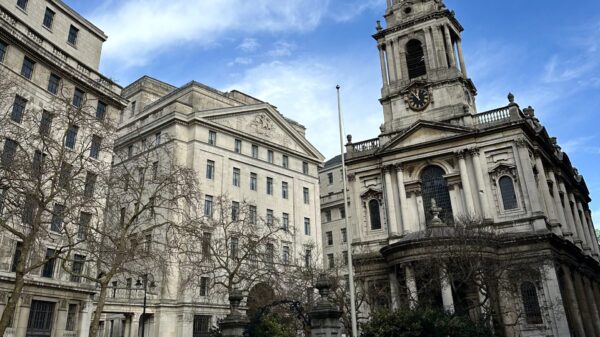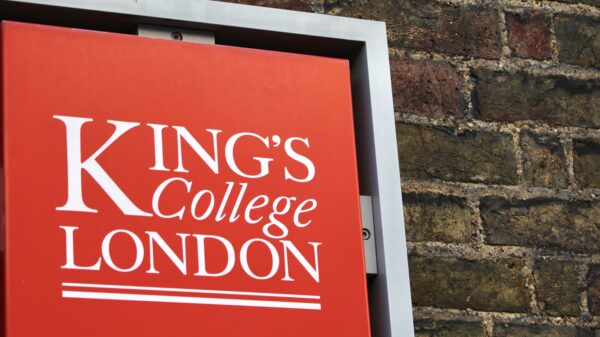Staff writer Charlotte Galea takes a look at the history of the building which neighbours the King’s College London Strand Campus.
Somerset House has been a film location, ice-skating rink and frequent photo opportunity. If you too have passed the magnificent Somerset House, you may have also wondered about its history. Recently, Roar was given a tour of the building by employees Paul, Katrina and Tabitha, giving us a comprehensive insight into the building many of us walk past every day. So, welcome to a whistle-stop tour of Somerset House, where four queens, hundreds of office clerks, thousands of sailors and more artists than I could count, called home.
The history of the House begins with a name – Edward. Henry VIII and his third wife Jane Seymour had a son in 1537, naming him Edward, after her brother. After ten years, the heir’s namesake was given some land near Temple Bar. When the king died the only possible heir to the crown was his nine-year-old son, Edward VI. But, as he was so young, a temporary monarch was required until the young boy came of age. Who better than his uncle, Jane’s brother – Edward Seymour, first Duke of Somerset?
Somerset became Lord Protector and established Somerset House for himself. Over the next five years, it became a palace where Somerset entered and exited from the Great Arch to the right, towards parliament, or to the left, towards high society, for a riot of a night out. He loved the high life that this position afforded him, but the high life didn’t seem to return those feelings. Due to an unforeseen and particularly aggressive coup, Somerset was accused of treason and executed in 1552.
Fortunately, the building wasn’t left empty for too long. Soon, a fresh-faced Princess Elizabeth, Henry VIII’s daughter and future Queen Elizabeth, was in need of London accommodation. She moved in at the tender age of twenty, making the House her home until her coronation in 1558. Then, it was used as a series of apartments for visiting ambassadors, who would fail in their attempts to marry their kings to the Virgin Queen.
Then comes James I of England and VI of Scotland, so good they named him twice. While he didn’t much care for city life, his wife, Anne of Denmark, adored Somerset House. Here she was free to do as she pleased, transforming the home into a centre of culture and entertainment, known for its brilliant masques – a beautiful combination of balls, galas and theatrical performances. The highest of society flocked to the House, enchanted by various circus acts, animals roaming the halls, plates of food and wonderous nights of dancing. Her time at the palace was so significant that it was named Denmark House for a time; here, the Treaty of London was signed in 1604, ending the Anglo-Spanish war. Society thrived in its gold-plated, musically enchanted walls until work concluded with Anne’s death of tuberculosis in 1619.
Charles I took the throne six years later and his queen consort, Henrietta Maria, also enjoyed entertaining. She continued the tradition of masques and spent her time commissioning the English architect Inigo Jones for more construction on the palace, including work on a Catholic chapel and a cemetery garden. In a Protestant and highly anti-Catholic country, this attracted hostility and in 1642, the Civil War began. Oliver Cromwell and his Parliamentary Army took over Somerset House, attacking and destroying the chapel garden in the year that followed. All that remains of this Tudor home is in the Dead House beneath the courtyard, where the last few headstones are ingrained in the walls of a structure now most frequently used for Halloween parties.
The end of the Civil War was a reset for the whole country, including the palace. The widow of King Charles I, Henrietta Maria, returned to France in 1665, making way for the last royal that would live in the House – Catherine of Braganza. The wife of Charles II led a very lonely life but nonetheless continued the hostess tradition, popularising the taking of tea and playing cards with her guests. In her time, the Great Fire of London swept over London but stopped just short of the House. Catherine lived mostly as a recluse, but we can hope that the old Tudor home might have offered some comfort in an uncomfortable life.
After Catherine’s departure, the palace was used primarily for navy barracks. This worked well, considering it already had apartments installed and was situated along the river. All that was needed was the addition of a few (hundred) beds.
Then arrived the age of expansion, conflict and conquest. Six monarchs had tried the crown before George III, fighting battles to maintain colonies, discovered that Somerset House was in a state of disrepair. Reports came to him of a crumbling old Catholic building, featuring debauchery (oh la la!) in its boats and gardens. In 1776, George III commissioned Sir William Chambers to build the structure we now know, asking for it to ‘reflect the triumph of mankind over nature’. AKA, no gardens, no greenery, and absolutely no boisterous students.
The work took 25 years but there are even parts hidden to the average eye. Below the railings surrounding parts of the courtyard are the lightwells, hallway-like passages in the buildings’ underbelly where servants would pass through. The house was now a structure built for an empire.
In 1776, the Royal Academy of Arts became the first resident in the North Wing, and the following year saw the residence of the Royal Society and the Society of Antiquities, with Somerset House hosting the first Royal Academy Exhibition. By 1788 the East and West wings were completed, and. Chambers died in 1796. He was replaced by James Wyatt who finished the building in 1801 at a whopping total cost of £450,000 in today’s money.
The navy occupied one-third of the site, the Stamp Office – the other third in the South Wing. While sailors slept soundly in their beds in London, across the Atlantic the navy was committing atrocities. They fought against France and Spain and protected ships transporting enslaved people to the colonies in the ‘New World’ to make their sugar, mine for their gold and pearls, and weave their cotton. The Slave Trade Act was passed in 1807, making it illegal to trade in slaves, though not to keep them. The navy then began work on patrolling the oceans for the next forty years, attempting to stop illegal trading.
The Victorian period brought new challenges; Somerset House had been in direct contact with the Thames, but the breakout of cholera changed things. 1858 brought the Great Stink, with the summer so hot and the Thames so overrun with waste, that the city smelled putrid. Parliament’s curtains were even soaked in lime chloride to stop the smell from affecting affluent politicians. This proved ineffective and people continued to die from the disease-ridden water. Thus, a sewage system was put in place, creating embankments like the one behind Somerset House, cutting it off from the Thames, but saving the lives (and noses) of the population.
Just next door, our very own King’s College London was opened in 1831. In the following year, the General Registrar’s Office was established at the House, though it is no longer there today. In 1849, the government department Inland Revenue took up residence and remained for 150 years. They even used the beautiful courtyard as a car park, until a movement to save Somerset House began in the new millennium and office workers had to find somewhere else to park.
In 1856, the New Wing was completed by James Pennethorne and the house remained much the same until the Second World War. Both sides of the war targeted places of cultural and economic importance; Somerset House was hit by a bomb in 1940 during a Blitz air raid. The Navy staircase and part of the South Wing were destroyed, until ten years later when Sir Alfred Richardson took on a two-year project to rebuild what had been broken. My brilliant tour guide Paul stated that if Nelson and Chambers had walked up the steps today, they wouldn’t have been able to notice the difference!
In 1997, the Somerset House Trust was established to preserve and develop the home for public use, opening the River Terrace to the public in 2000 for the first time in more than a century. In that same December, the temporary ice rink that we know and love was installed for the very first time. In 2011, Inland Revenue departed from the building and the house became purely a place for the arts. In 2016, Somerset House Studios was launched and the home welcomed resident artists like Gareth Pugh, Anna Meredith and Tai Shani, amongst many others whose works are well worth visiting.
Somerset House is a beloved building, protected by multiple trusts as an integral asset of the city’s landscape – for photo opportunities, ice-skating and for the artists who call it their home like their royal predecessors. I will certainly have to stop and think about the many people who passed through its age-old doors the next time I’m on my way to class.












